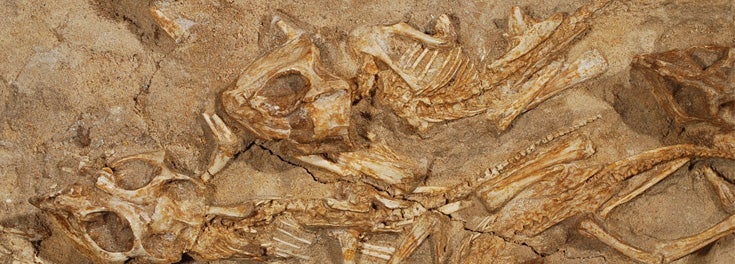
URI has its very own dinosaur hunter, and we call him Professor David Fastovsky. In fact, he’s so widely known for his research on the extinction of dinosaurs that his wax likeness lives immortally in the Milwaukee Public Museum as part of a diorama explaining the clay layer of Earth that marks the boundary between two different geological periods.
And, he’s practically famous for his 2011 discovery of a 70-million-year-old nest containing the fossilized remains of 15 Protoceratops andrewsi dinosaurs in Mongolia. The bowl-shaped nest measured 2.3 feet in diameter and all 15 dinosaurs it contained were about six inches tall and less than a year old. It’s the first nest of this genus ever found, and the first time we have evidence that Protoceratops juveniles remained in the nest for an extended period.
My whole career has been devoted to understanding the environmental transition going across the boundary. When the dinosaurs went extinct, did they go gradually or quickly? ~Professor David Fastovsky
News of his discovery and findings from his study were reported hundreds of times worldwide in such publications as Smithsonian, National Geographic and Discovery News, and has appeared in numerous languages on websites in Spain, Peru, Chile, Mexico, Poland, Kyrgyzstan, Croatia, Italy, India, Ecuador, and many more countries.
So we weren’t surprised this year when the geosciences professor received a Fulbright scholarship to study the environmental conditions that existed in Europe when the dinosaurs went extinct.
Professor Fastovsky has spent most of his career studying the Cretaceous-Tertiary boundary, the period of time when the non-avian dinosaurs went extinct 65 million years ago. He published a paper in 2005 that summarizes what is known about the extinction of dinosaurs in North America, but “there are no meaningful data about this period from anywhere else in the world…. We know there are locations in Spain and France that contain dinosaurs at the boundary. I want to see what we can learn about the distribution of fossils there.”
“My whole career has been devoted to understanding the environmental transition going across the boundary. When the dinosaurs went extinct, did they go gradually or quickly? To understand that, you have to understand the processes of sedimentation and the environment in which their bones are preserved, or you can’t assess what the distribution of those bones in time really means. That’s what we’re after,” he said.
Truth is, Professor Fastovksy’s just one example of the kind of leading innovators and discoverers you’ll find in the geosciences at URI. You could also study with leading experts on underwater volcanoes, award-winning faculty studying earthquakes and the evolution of Earth, the developer of a seismic model to monitor for nuclear explosions in the Middle East, or a hydrogeologist working to find drinking water sources in poor areas of India, Jordan and other nations. Which is why it may be the only academic discipline at URI where it’s fun to be between a rock and a hard place.
Photo credit: Dr. Kh. Tsogtbaatar, Director of the Mongolian Paleontological Center, Ulan Baatar, Mongolia
Related Links:
Journal of Paleontology article: A nest of protoceratops
Science Illustrated article: Nest of juvenile dinosaurs discovered
SciTechDaily article: Nest of Juvenile Protoceraops Andrewsi Dinosaurs Discovered
